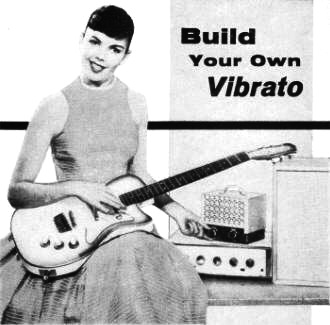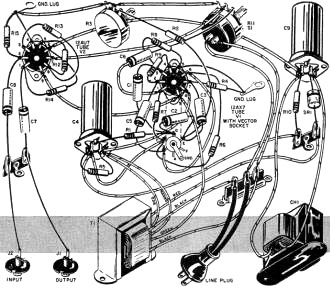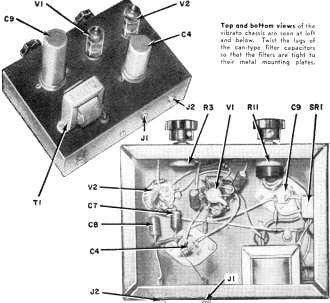Build Your Own "Throbbing" Vibrato
|
|
RF Cafe visitor Jim L. requested that I post this Build Your Own Vibrato article from the December 1957 edition of Popular Electronics magazine. "Make like Elvis with an 'electronic' throbbing guitar," is the pitch line. Vibrato, for the non-musically inclined, is the "wa-wa" sound of an instrument as it smoothly wavers in pitch about a central note. This circuit is for use with an electric guitar, but acoustical stringed instruments like the violin and cello are routinely played with vibrato effect by rocking the finger up and down the length of the string. In typical 1950s style, the project is built with point-to-point wiring rather than using a printed circuit board. Build Your Own Vibrato - Make like Elvis with an "electronic" throbbing guitar. By Frank H. Tooker If you own an electronic musical instrument or a conventional instrument equipped with a pickup, chances are that the vibrato described in this article is just what you've always wanted. A vibrato is a device which continuously and automatically varies the amplitude of the music at a low rate of speed, usually somewhere in the range of 6 to 15 times per second. For instance, it is a vibrato which produces the soul-stirring throbbing, especially in the bass notes, of a pipe organ. Construction. Layout and wiring are not especially critical. For convenience a turret socket was used to mount the oscillator tube, V1, and its components, but a standard socket and tie points will do as well. Miniature coaxial jacks, of the type found on most hi-fi amplifiers, were used at J1 and J2 for the output and input connections, respectively. If your setup requires something different, any conventional type of jack may be employed. Keep the power supply components well separated from the oscillator and modulator components, to prevent hum pickup - and orient the tube sockets for reasonably short lead connections. Make sure that the 6.3-volt heater leads are dressed snugly against the chassis and that they are well separated from grid terminals and leads. A miniature amplifier foundation (Bud No. CA-1754) was used for a chassis (any other setup of suitable size can be substituted). The Bud chassis measures 5" x 7" X 2", and its over-all height with the grille cover in place is 6". The finish is black crackle - but if some other color appeals to you, it's a simple matter to go over the chassis with a couple of coats of plastic spray. Vibrator Circuit Point-to-Point Wiring Diagram. Parts List CI, C2, C3, C5-0.05-µfd., 200-volt, metalized paper capacitor C4a/C4b-20/20-µfd., 150-volt, dual electrolytic capacitor C6, C7, C8-0.02-µfd., 200-volt, paper capacitor C9a/C9b-40/40-µfd., 250-volt, dual electrolytic capacitor CH1-3.5-henry, 50-ma. filter choke J1, J2-Miniature phono jack R1 R4, R7, R8, R10-220,000-ohm, 1/2-watt resistor R2, R6-100,000-ohm, 1/2-watt resistor R3-500,000-ohm potentiometer (Rate control) R5-10,000-ohm, 1/2-watt resistor R9-3.9-megohm, 1/2-watt resistor R11-500,000-ohm potentiometer (Depth control) R12-27,000-ohm, 1/2-watt resistor R13-560-ohm. 1/2-watt resistor R14-47,000-ohm, 1/2-watt resistor R15-470,000-ohm, 1/2-watt resistor S1-S.p.s.t. switch (on Depth control) SRI-20-ma., 130-volt selenium rectifier T1-Miniature power transformer, 125 volts at 15 ma., 6.3 volts at 0.6 amp. (Stancor PS-8415) V1-Type 12AX7 tube V2-Type 12AU7A tube 1-Miniature amplifier foundation chassis or equivalent (see text) 1-Turret-type miniature 9-pin tube socket 1-Miniature 9-pin tube socket Misc. hardware, grommets, tie points, etc. In some instances, it may be possible to mount the vibrato circuit proper on the same chassis with the musical instrument amplifier. This can be done provided that there is room, and that the power transformer in the amplifier can supply the 0.6-ampere additional filament current demanded by the two vibrato circuit tubes. The plate voltage requirement is approximately 175 volts.
Vibrato Circuit Schematic Top and bottom views of the vibrato chassis are seen at left and below. Twist the lugs of the can-type filter capacitors so that the filters are tight to their metal mounting plates. Schematic and pictorial at left show the simplicity of the vibrato construction. If your amplifier tends to "thump" at vibrato frequency, try a lower value capacitor for C7. Block diagram shows correct interconnection of the three basic components of the revised setup. Use shielded microphone cable between units to prevent electrostatic hum pickup. If there seems to be excessive 60-cycle hum present, try reversing line plug of either amplifier or vibrato unit. Vibrato Circuit Chassis Assembly Photo Hooking It Up. The vibrato is intended to be inserted or connected between the musical instrument and its amplifier. All you have to do to use it is unplug your musical instrument from its amplifier and plug it into the input jack of the vibrato. Then connect a jumper cable of convenient length between the output jack of the vibrato and the input jack of the amplifier. The Rate control determines the rate or frequency of the vibrato effect. i.e., the speed at which the rise and fall in amplitude occurs. Proper setting of this control depends upon the type of instrument with which the vibrato is used and the type of music being played. Component values given in the parts list permit the unit to be adjusted over the most useful range of speeds. How It Works The schematic shows that the vibrato consists of two parts: (1) a very low frequency audio oscillator, and (2) a modulator. The low-frequency oscillator is of the phase-shift type which uses resistors and capacitors C1, C2, C3, R1, R2 plus R3, and R4 in three RC sections to obtain feedback in the proper phase to produce oscillations. The rate or speed of the vibrato, i.e., the frequency of the oscillator, is determined by the resistance and the capacitance used in the RC sections. Thus, R3 is the Rate or speed control of the vibrato. V1's second triode section serves a dual purpose: (1) it provides a low source impedance for the RC feedback loop (taken from the cathode), and (2) it acts as a buffer to isolate the oscillator from the connection to the modulator (taken from the plate). The low-frequency oscillator signal is fed through the gain or Depth control, R11, to the control grid of one section of the twin-triode modulator, V2. At the same time, the output signal from the musical instrument is fed through to the control grid of the second section. The two signals mix in V2, with the result that the gain or amplification of the musical signal is made to increase and decrease, smoothly and periodically, at the rate of the low-frequency oscillations. Output from the modulator is taken through C7 and coupled to the input of the musical instrument's conventional amplifier. Plate current demand is very small, so a miniature power transformer, T1, and a miniature selenium rectifier. SR1, more than meet the requirement. The Depth or vibrato-frequency gain control determines the amplitude of the vibrato effect. The more this control is advanced, the more pronounced the vibrato effect becomes. Proper setting depends upon the strength of the musical signal fed to the modulator as well as on the type of instrument and the selection being played.* Probably the best method is to adjust the Rate and Depth controls for the most pleasing effect. You can get some idea as to proper settings by listening to recordings in which a vibrato is used. Many beginners tend to use too much vibrato, or to use it too frequently. Much can be learned by listening to professionals. Possible Troubles and Cures No Vibrato Effect: Check all wiring for errors. Make sure input and output plugs are making good contact in the jacks. Look for faulty components. Check the tubes. Make sure the 12AX7 tube is in the oscillator socket, the 12AU7 in the modulator socket, and not vice-versa. Check interconnecting cables for a poor solder joint or broken wire. Distortion: Most, if not all, vibratos cause a certain amount of distortion. However, the effect should not be objectionable. Reduce the setting of the Depth control slightly to see if it improves the condition. If so, check the musical signal voltage at the input to the modulator. An input greater than 0.7 volt r.m.s. may cause distortion. Check the value of components around the modulator. Look for a possible defective component. And check the modulator tube. Thumping in Speaker: A thumping noise at the vibrato rate may be due to low frequencies pulling the voice coil or cone out of linearity. This isn't likely to happen unless you have an amplifier with exceptionally heavy bass response. A high-pass filter cutting off at about 100 cycles inserted between the vibrato and the amplifier may be necessary in such cases if all else fails. Hum: Hum can come from a variety of sources such as a poor layout of components, excessively long leads or poor lead dress, a defective modulator tube, faulty filter choke or capacitors, unshielded interconnecting cables or cables with the shield ungrounded to chassis, using the unit close to power wiring carrying heavy a.c. currents, etc. All of these possible troubles can be easily corrected. * Maximum musical signal voltage should not be greater than approximately 0.7 volt, to prevent overloading the unit. Optimum operation occurs with a musical signal input from the contact microphone between 0.5 and 0.7 volt.
Posted June 13, 2022 |
|




